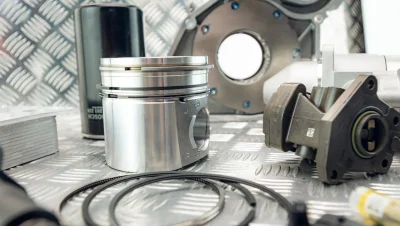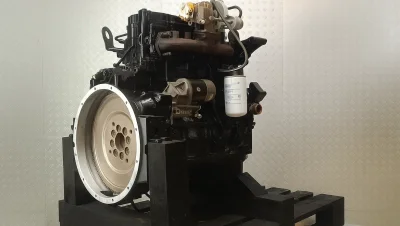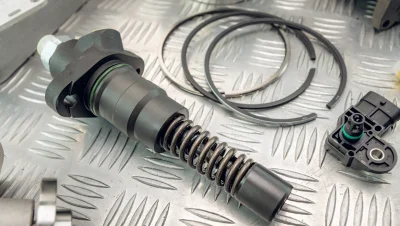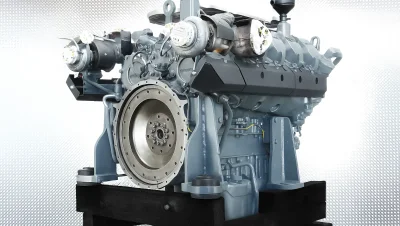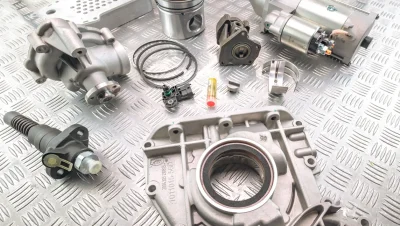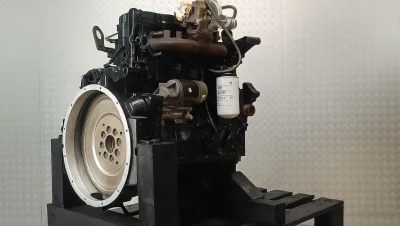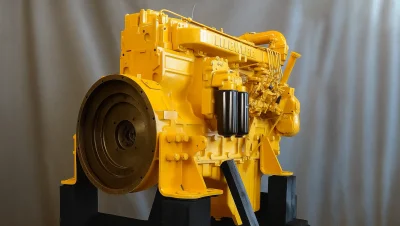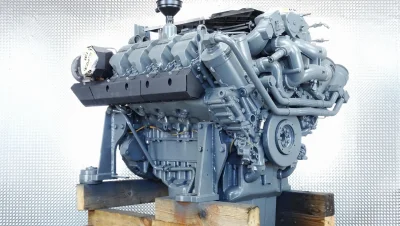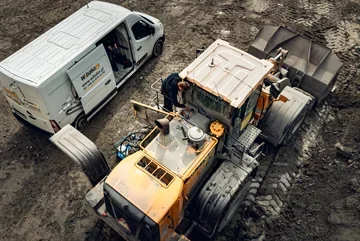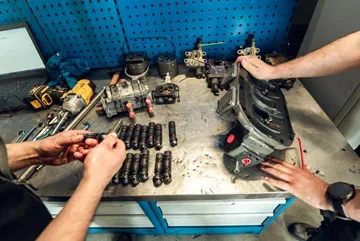Engine Overhaul of Liebherr D 9408 TI-E in Liebherr LTM 1300/1 Mobile Crane
Introduction
The Liebherr LTM 1300/1 mobile crane is an impressive heavy-lift machine that has remained one of the pillars of the crane industry for many years. Equipped with a powerful Liebherr D 9408 TI-E V8 engine with an output of approximately 440 kW (around 590 HP), this crane requires exceptionally precise handling and regular inspections. The machine arrived at our service center near Katowice (Silesian Voivodeship), where our mobile service performed initial diagnostics and disassembly of the power unit. The engine was transported to WIBAKO's headquarters in Kojszówka, where we began the complete rebuilding process.
The machine's manufacturer, Liebherr, is one of the leaders in the global crane industry. The D 9408 TI-E series engines are valued for their high torque and durability, but under heavy operational loads, they can experience natural wear. In this case, the reason for the repair was clear signs of wear on the cylinders and pistons: a drop in compression, smoking under load, and increased oil consumption.
Initial Diagnostics in the Machine
Our mobile service began diagnostics by measuring the compression pressure in the individual cylinders of the D 9408 TI-E engine. The results clearly indicated low compression in several cylinders. To confirm, a cylinder leak test and endoscopic examination were performed. The endoscopic camera revealed wear on the cylinder walls and clear signs of burning on the piston crowns.
To unequivocally confirm the cause of the failure, we disassembled the air intake, cooling system, and wiring, and then conducted a final test of the unit's operation under light load. The engine generated unnatural vibrations and smoke, confirming the necessity for a comprehensive rebuild.
Disassembly of the Engine from the Machine
The disassembly of the power unit from the LTM 1300/1 crane was carried out using a crane provided by the client. Our technicians removed all necessary components: fuel lines, air intake, exhaust pipe, cooling system, electrical harnesses, and engine mounts. Before disconnection, the components of the cooling system and air intake were properly secured to prevent contamination.
After uncoupling the engine from the drive system and unscrewing the engine mounts, the unit was carefully lifted and placed on a transport stand. The engine was taken to our facility in Kojszówka, where the full verification and rebuilding process began.
Engine Verification in the Workshop
After disassembling the engine into its components, we confirmed the initial diagnosis. We found:
- significant wear on the cylinder walls,
- excessive play on the piston rings,
- signs of overheating on the sleeve parts,
- valves requiring complete regeneration,
- a turbocharger with noticeable play.
The verification included measuring the crankshaft, checking all connecting rods, assessing the camshaft, inspecting the injection pump, and conducting leak tests on the cylinder heads. The oil channels were checked for contamination, and all parts were thoroughly cleaned.
Repair Process of the D 9408 TI-E Engine
Crankshaft-Piston System
The crankshaft-piston system underwent a thorough rebuild. We used new pistons, rings, bearings, and cylinder sleeves. The crankshaft was ground and regenerated, and then balanced. The connecting rods were checked for cracks, twisting, and weight-matched.
Engine Cylinder Head
The cylinder heads underwent complete regeneration: surfacing, replacement of guides, machining of valve seats, and installation of new valves. Each head was subjected to a leak test in a heated water bath, ensuring that it had no micro-cracks.
Fuel System
The injection pump was sent to a specialized external facility, where it underwent complete regeneration and calibration. The injectors were tested on a test bench, tips were replaced, and appropriate opening pressures were set. The supply pump was also regenerated.
Engine Accessories
The turbocharger underwent complete regeneration. The alternator, starter, and other electro-mechanical components were fully verified. All seals, hoses, O-rings, and rubber components were replaced with new ones.
Professional Assembly of the Engine
The engine assembly process was carried out according to the manufacturer's guidelines and with adherence to tightening torques. Each stage was documented, and the oil channels were additionally checked for flow. The unit was prepared for testing on the dynamometer.
Testing on the Engine Dynamometer
One of our greatest assets is the engine dynamometer, which allows for full testing of the unit before installation in the machine. The Liebherr D 9408 TI-E engine operated on the dynamometer for over 16 hours under a load of 20-30%, which allowed for proper seating of the crankshaft-piston system components.
After the initial phase, we began testing under full load. The engine was subjected to maximum operating parameters multiple times, monitoring temperatures, oil pressures, and operating culture. The tests showed correct torque characteristics, stable oil pressure, and proper combustion. The engine passed the tests without any reservations.
Installation of the Engine in the Crane
The installation of the engine in the Liebherr LTM 1300/1 crane is a process that requires exceptional precision. Our mobile service conducted the installation of the unit at the machine's work site. The engine was introduced into the frame using a crane provided by the client. Then, the mounts, couplings, and all hoses: fuel, oil, cooling, and air were installed.
Additionally, we conducted a complete replacement of the air piping, seals, and rubber hoses that had worn out. After connecting the electrical system, we performed a leak test of the entire system. The first start-up took place in the presence of the operator. For several hours, we checked the operating parameters, operating culture, and absence of leaks.
After the successful completion of the tests, an installation protocol was issued, and the machine was handed over for further operation.
Engine Maintenance After Overhaul
The engine after overhaul is covered by a warranty. We recommend the first filter change after 50 operating hours and a full inspection of connections, hoses, and the overall condition of the accessories. Subsequent inspections every 250 operating hours, but no less than once every 3 months.
In Which Machines the D 9408 TI-E Engine is Used
This engine is mainly used in large Liebherr LTM mobile cranes, as well as in other heavy specialized applications where high power and high resistance to loads are required.
Summary
The comprehensive overhaul of the Liebherr D 9408 TI-E engine in the LTM 1300/1 crane allowed for a complete restoration of its efficiency. Thanks to the dynamometer tests and professional assembly, the machine is fully ready for operation. The next service inspection will take place after 50 operating hours, in accordance with WIBAKO's recommendations.
Liebherr Engine Service
Contact us if your machine requires engine repair or regeneration. We offer comprehensive service, engine dynamometer testing, and mobile service team visits throughout Poland.



